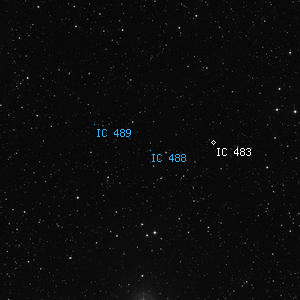IC 488

Overlaid DSS image of IC 488, 60' x 60' with north at top and west to the right
Aladin viewer for the region around IC 488
| Type | Star |
|---|---|
| Magnitude | Right Ascension | 8h 0' 48.7" (2000) |
| Declination | 25° 54' 6" N |
| Constellation | Cancer |
| Description | vF, S, dif, ? 13 sp |
Observing Notes
Harold Corwin
IC 488 may be the star with the accompanying faint, compact galaxy that Wolfgang has chosen. But Rudolf Spitaler's very precise position, measured with respect to two different comparison stars on the same night (8 Feb 1891), is over 20 arcseconds away. His two measurements, reduced with respect to the AC2000.2 positions for the comparison stars (epoch 1902.43, close enough to Spitaler's observation date that I've ignored the eleven plus years of proper motion), are accordant to within two arcseconds. I had originally thought that his object was the triple star on to the east of the double, but that is even further from his measured place. All the candidate stars for IC 488 are listed in the position tables.
Another mystery: In his description of his nebula, Spitaler mentions a 13th magnitude star 16.84 seconds preceding, 20.4 arcsec south of his nebula. That star was 15.74 seconds west and 34.4 seconds south of the double (for equinox 1891.11). But reducing his offsets with respect to the AC2000.2 position (epoch 1903.35) for the star leads to a position 1.88 seconds of time on east and 30.9 seconds south of his other two positions. So, his three measurements are not internally consistent.
For the time being, I've listed the star+compact as the most likely candidate, but am not convinced that either it or the triple was Spitaler's object. In addition, he calls it a quarter of an arcminute in diameter. While the distance across the triple is about 20 arcseconds, the separation of the star and galaxy is only 4.6 arcsec.
The other obvious option is a comet. But this seems unlikely as Spitaler's three measurements are not internally consistent and I think he would have noticed a comet's motion against the background stars (unless it was very distant, of course).
So, I suspect some sort of errors in his observations, but cannot even guess what they might be.
I also should note that I mistook the compact galaxy for a star when I first saw it (my previous note calls the pair a double star). But having loaded the SDSS into NED, and revisiting the IC objects a couple of months later, I found that the SDSS team had actually taken a spectrum of the galaxy and found it to have a redshift of z = 0.1919 (57,530 km/s). This is one of the largest redshifts for any object in the IC, and makes it less likely -- in my mind, at least -- that Spitaler actually could have seen it. The SDSS g-band magnitude is around 18, probably too faint for the galaxy to have been picked up even with Spitaler's 27-inch refractor. Perhaps the galaxy added a bit of fuzz to the nearby star, but I'd want to check it in a similar-sized telescope.
Other Data Sources for IC 488
Nearby objects for IC 488
15 objects found within 60'
| IC 2215 | IC 482 | IC 483 |
| IC 484 | IC 485 | IC 486 |
| IC 489 | IC 490 | IC 491 |
| NGC 2486 | NGC 2487 | NGC 2498 |
| Omega Cancri | Omega Cancri 2 | PGC 1779405 |
Credits...
Drawings, descriptions, and CCD photos are copyright Andrew Cooper unless otherwise noted, no usage without permission.
A complete list of credits and sources can be found on the about page
IC 488